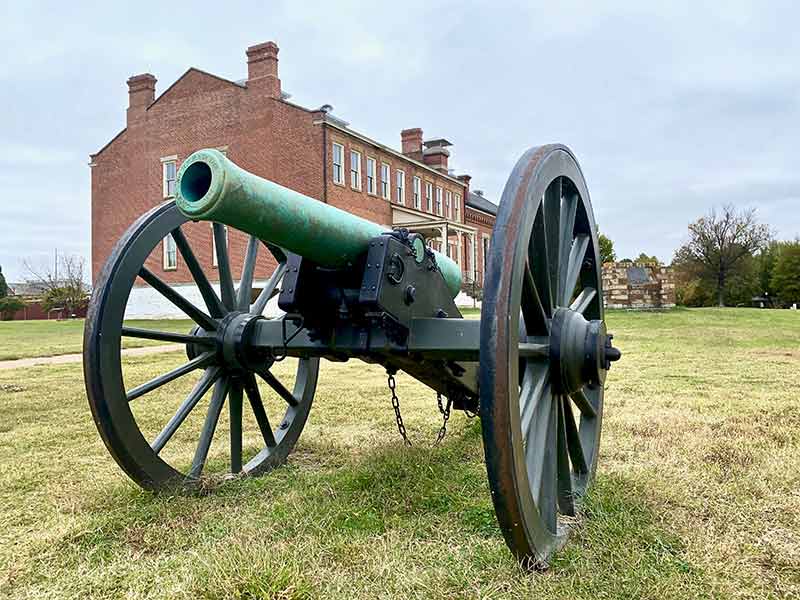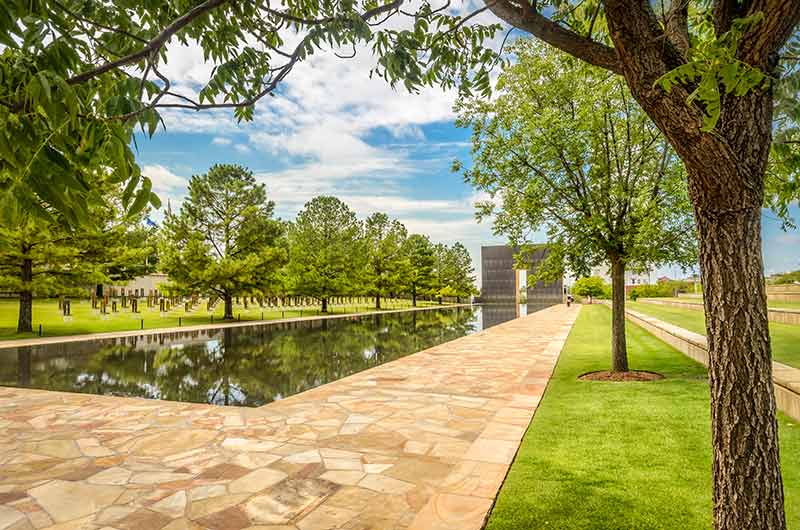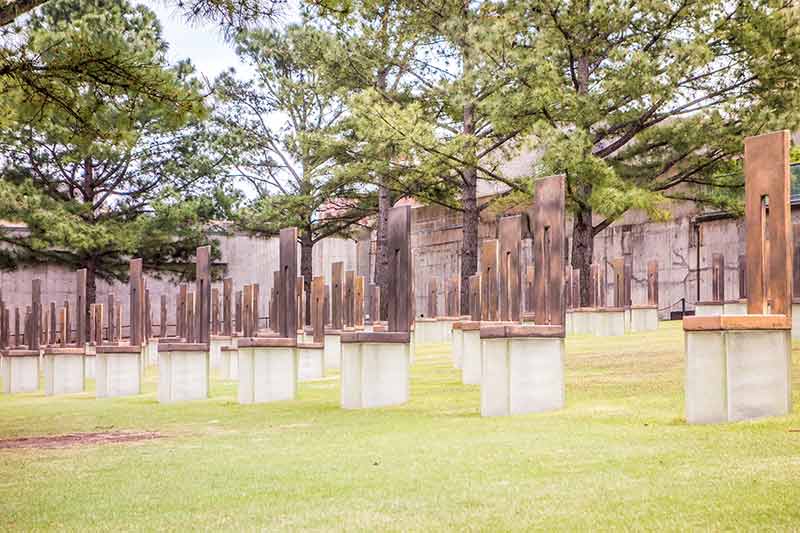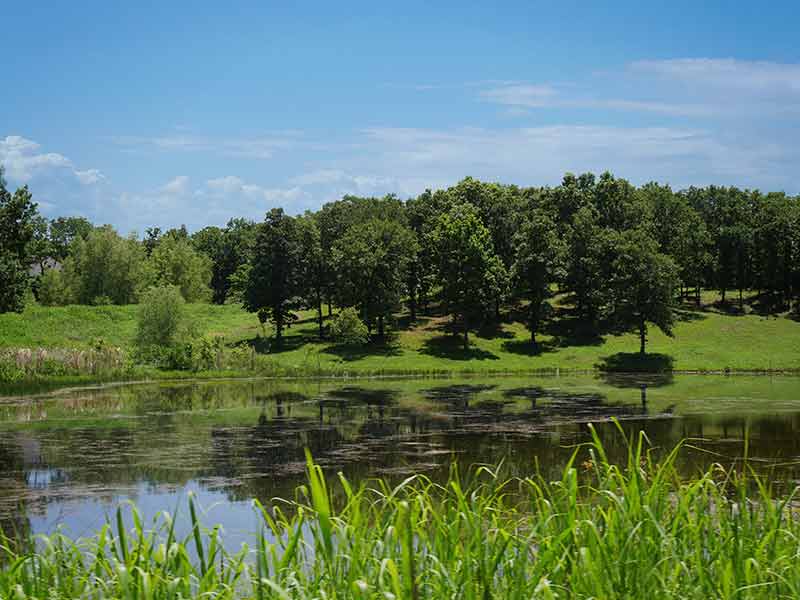Oklahoma has six national parks, including historic sites, a national memorial, historic trails, a recreation area and a national wildlife refuge. Oklahoma is known for its beautiful mountain ranges, parks, lakes, and cultural and historical heritage. It might not be on your immediate list of U.S. states to visit, but it is sure a state of outdoor surprises and hidden gems.
While you might not instantly think of Oklahoma as a state filled with national parks, it has an astonishing amount of places to discover. Texas, Kansas, Arkansas, New Mexico, Colorado and Missouri border the ‘Sooner State’ in the South Central United States. Check out these seven national parks in Oklahoma, and you may be surprised.
Contents
National Parks In Oklahoma
Top Tours
- Waterfalls and Blue Ridge Parkway – Hiking Tour with Expert Naturalist
- Guided Horseback Ride through Flame Azalea and Fern Forest
- Oklahoma City National Memorial Museum Tickets – skip the line and book your tickets here.
National Historic Sites
1- Fort Smith National Historic Site

The Fort Smith National Historic Site is on the Oklahoma-Arkansas border at the confluence of the Poteau and Arkansas Rivers.
If you are interested in things to do with the military, then this national historic site is well worth a visit.
Fort Smith was first established in 1817 to maintain peace between the Cherokee and Osage tribes in the area.
At this national historic site, you will be able to learn about the life of people close to the Indian territory.
After just seven years of operation, Fort Smith was left abandoned for more than 200 years.
Visitors to the fort can walk around the grounds and visit the federal courthouse, commissary building and officer’s gardens.
If you love bird watching, wandering around Fort Smith’s trails will allow you to spot some magnificent species.
You can also head to the military barracks and Judge Parker’s courtroom.
Parker earned the nickname the “Hanging Judge of the American Old West” after sentencing 160 people to death, 79 of which were executed.
There’s a $10 entry fee, and the site is open year-round with slight seasonal changes.
You can usually head to the park between 9am and 5pm daily.
Fort Smith is at 301 Parker Avenue, Fort Smith, AR 72901.
2- Washita Battlefield National Historic Site
Washita Battlefield is a significant site that commemorates the clash between U.S. Military and Native Americans.
The Battle of Washita occurred on 27 November 1868, when Lieutenant Colonel George Armstrong Cluster and his troops surprised the Cheyenne village.
The U.S. troops claimed victory, and as a result, the Cheyenne people were forced back onto their allocated reservation.
However, the story Cluster and his troops told was different from other reports of the event.
Cluster and his troops reportedly massacred over a hundred people, including the chief and his wife.
Historians have discovered that it certainly was not a battle and that it was indeed a senseless massacre.
At the so-called Washita “Battlefield” National Historic Site, you can learn the history of the Cheyenne people and this terrible event.
You can walk along the one-and-a-half-mile trail which provides you with stops to read about this historical event.
The accompanying Dust & Fire Trail is shorter but allows you to discover things about life on the prairie and explore the wildlife, flora, a dugout house and a working windmill.
Start at the visitors’ centre, where you can learn all about the massacre, the area and the Cheyenne people.
There is also a 27-minute film called Destiny at Dawn.
Washita Battlefield National Historic Site is a place of reflection and remembrance for those Cheyenne people killed by the U.S. troops.
Visiting this site provides time to reflect on the appalling treatment of Native Americans on native lands.
Cheyenne is the nearest town to the Washita Battlefield National Historic Site.
National Memorials
3- Oklahoma City National Memorial

One of the most emotionally provoking national parks in Oklahoma is the Oklahoma City National Memorial.
This national memorial was created in memory of the people who lost their lives and all affected by the senseless Oklahoma City bombing.
On 19 April 1995, Terry Nichols and Timothy McVeigh detonated a bomb at the Alfred P. Murrah Federal Building.
The bombing happened at 9:02 am, right when everyone was going to work.
168 people lost their lives, and more than 680 people were injured.
One-third of the building was destroyed, and it was later demolished.

There are three main spots of remembrance at this national memorial: the Field of Empty Chairs, which stands tall and made of copper to represent those who lost their lives in the attack and the Rescuers’ Orchard, which commemorates all of the hard work that the first responders put into saving the lives of those in the attack.
Finally, a Reflecting Pool sits in front of the Field of Empty Chairs, almost so the people who lost their lives now have somewhere beautiful to look out towards.
The Oklahoma City National Memorial is open year-round and costs $15 for adults and $12 for children to enter.
President Bill Clinton authorised this national memorial on 9 October 1997 with the signing of the Oklahoma City National Memorial Act.
Oklahoma City National Memorial is at 620 N Harvey Avenue, Oklahoma City, OK 73102. Skip the line and reserve your tickets here.
- 20 Oklahoma Landmarks
- 20 Things To Do In Oklahoma City
- 20 Things To Do In Tulsa
- 7 Oklahoma National Parks
- 20 Oklahoma Cities
- 20 State Parks in Oklahoma
- 15 Things Oklahoma Is Famous For
- 20 Things To Do In Norman
National Historic Trail
4- Santa Fe National Historic Trail
Oklahoma is another U.S. state that played an important role in the Westward Migration during the 19th century.
Between 1821 and 1880, the Santa Fe Trail acted as the highway that connected Missouri and Santa Fe in New Mexico.
William Becknell pioneered this important economic route and by 1925 several commodities were being traded in Santa Fe.
This historic trail stretches across 900 miles and passes through five states, including Missouri, Kansas, Colorado, Oklahoma and New Mexico.
Of the five states, Oklahoma benefited least from the trade route even though the state played an important role in sustaining the people travelling along the route.
Oklahoma is home to the smallest section of the Santa Fe trail.
The trail had two major branches, only one of which crossed through Oklahoma, that was the Cimarron Route.
The Cimarron Route was just 46 miles long and traversed the northern border of Oklahoma with Colorado.
The route originally saw people walking on foot and horseback, but today, though there are no official walking trail routes, people hop on and off the trail across the five states.
Oklahoma’s section of the trail passes across a small section of the Panhandle near Boise City.
You can visit the Cimarron Heritage Center, where you can explore their Santa Fe exhibit and learn about the first pioneers to cross the pathways to Mexico.
Visitors to Oklahoma’s section of the Santa Fe trail can also visit Autograph Rock and Cold Springs Creek, both of which are popular spots for travellers to rest and have a picnic.
The entire area has plenty of picnic areas set just off the road, all with great and expansive views.
Today the Santa Fe National Historic Trail has a variety of museums, historic sites and landmarks scattered along the original route.
5- Trail of Tears National Historic Trail
The Trail of Tears National Historic Trail represents a harrowing element of Native American history at the hands of the U.S. government.
Unfortunately, throughout American history, Native American people were continually mistreated, and the story of the Trail of Tears is no exception.
In 1830, Congress passed the Indian Removal Act, approved by the seventh U.S. President, Andrew Jackson.
Before his presidency, he spent years campaigning against the Indian nations and encouraging the removal of their land.
When he became president, he signed the Indian Removal Act, which gave the federal government power to exchange Native American land in the lucrative cotton kingdom situated east of Mississippi for land to the west in an area known as the “Indian colonisation zone”.
This land was purchased as part of the Louisiana Purchase.
This Indian territory was located in present-day Oklahoma.
U.S. Army troops forcibly evicted more than 16,000 people from the Cherokee community.
They were forced from their native lands in Tennessee, North Carolina, Alabama, and Georgia.
The route was more than 5,000 miles long, passing through nine states. Extremely harsh winters, river crossings and difficulties finding food resulted in at least 3,000 Native Americans dying on their trip to their new forced lands.
Today you can follow the trail on foot, by car, by bike, on horseback or along the riverways.
Along the route, several sacred sites depict the struggles of the Cherokee people.
While you are in Oklahoma, check out the Cherokee Heritage Center in the foothills of the Ozark Mountains in 44 acres of heavily wooded forest.
Here you can learn about the Trail of Tears through an informative exhibit.
National Recreation Area
6- Chickasaw National Recreation Area

If you are visiting Oklahoma and are keen to step outside and explore the countryside, you should head to Chickasaw National Recreation Area.
The history of this recreation area started in 1902 when the U.S. Government bought 640 acres of land from the Chickasaw Nation to protect the freshwater and mineral springs.
By 1906 additional acreage was added, and the area was renamed Platt National Park.
By 1976 the Platt National Park and the Arbuckle Recreation Area joined together to form the Chickasaw National Recreation Area.
This beautiful park now spans 9,900 acres and has around 2,409 acres of springs, lakes and streams.
The Chickasaw National Recreation Area is in southern Oklahoma, around 85 miles (1 hours 20-minute drive) from Oklahoma City.
You simply must add this outdoor activity to your Oklahoma bucket list.
The Chickasaw National Recreation Area is a stunning and calming place to visit.
There’s beautiful foliage, wildlife viewing opportunities, and an oasis of water bodies from streams to lakes and tiny springs.
Check out the recreation area’s 30 miles of trails if hiking is your thing.
Both experienced, and novice hikers will thoroughly enjoy this park.
If it’s your first time in the park, head to the Travertine Nature Center where you can learn about the park and discover the routes of the different trails.
Inside the centre, there are a surprising number of exhibits, and you can also ask about the recreation area’s ranger-led programs, which include guided hikes and environmental educational tours.
The Chickasaw National Recreation Area is at 901 W 1st Street, Sulphur, OK 73986.
National Wildlife Refuge
7- Deep Forest National Wildlife Refuge
The next stop on this list of Oklahoma national parks is the Deep Forest National Wildlife Refuge. Admittedly, this isn’t exactly a national park; it is managed by the U.S. Fish & Wildlife, but it’s a great place to visit, so it has snuck onto this list!
This wildlife refuge was established in 1993 to protect Oklahoma’s bottomland hardwood forest.
This is a truly spectacular outdoor area with breathtaking natural scenery.
This refuge is 10,000 acres and is a crucial site for migrating waterfowl that travel along the Central Flyway during spring and fall.
This refuge is filled with hardwood forest trees, including the black walnut, bur oak, hackberry, pecan, pin oak, cottonwood, and river birch.
Immerse yourself in nature by discovering different tree species and a plethora of fauna.
There are 254 bird species at the Deep Forest National Wildlife Refuge. Within the Deep Fork River basin, there have been 51 mammal species recorded.
Okmulgee County is an excellent destination for wildlife viewing, with more than 50 reptile species and 22 amphibians.
The Deep Forest National Wildlife Refuge is in east central Oklahoma, about 100 miles east of Oklahoma City.
Deep Forest National Wildlife Refuge is at 21680 US-75, Okmulgee, OK 74447.
Recommended tour: Blue Ridge Parkway Waterfalls Hiking Tour from Asheville
If you love exploring national parks, you might like to read:
- Wyoming National Parks Guide
- Nevada National Parks Guide
- Michigan National Parks Guide
- 5 Maine National Parks
- New Hampshire National Parks Guide
- 25 National Parks in Canada
- 17 National Parks in Argentina
- Tasmania National Parks
- 20 National Parks in Mexico
- 18 New Mexico National Parks
- 18 National Parks in Massachusetts
- 17 Colorado National Parks
- 4 Indiana National Parks
- 5 Nebraska National Parks
- 30 Virginia National Parks
- 9 New Jersey National Parks
- 8 National Parks in Arkansas
- 8 Alaska National Parks
- 13 Tennessee National Parks
- 6 National Parks in Louisiana
- 5 Illinois National Parks
- 7 National Parks in Oklahoma
- 7 National Parks in South Dakota
- 12 Alabama National Parks
- 5 North Dakota National Parks
- 8 National Parks in West Virginia
- 20 National Parks in Arizona
- 11 National Parks In Florida
- 8 Hawaii National Parks
- 6 National Parks In Idaho
- Texas National Parks Guide
- 9 California National Parks
- 11 National Parks In Georgia
- 7 National Parks In Missouri
- 5 National Parks in Minnesota
- 7 National Parks In Kentucky
- 8 National Parks In Montana
- 15 National Parks In Washington State
- 8 South Carolina National Parks
- 12 North Carolina National Parks
- 4 Wisconsin National Parks
- 20 National Parks In India
- 11 Oregon National Parks
- 5 Connecticut National Parks
- 27 National Parks In New York State
- 4 Iowa National Parks
- Yosemite National Park
- Zion National Park
- 21 National Parks in Pennsylvania
- 9 National Parks in Mississippi
- 5 National Parks in Rhode Island
- 9 National Parks in Taiwan
- 20 East Coast National Parks
- Guide To Winter in Yellowstone National Park
Plan Your Trip

Rent A Car – Find the best car rental rates at Discover Cars. They compare car hire companies to provide you with the best deal right now.

Find A Hotel – If you’re curious about this article and are looking for somewhere to stay, take a look at these amazing hotels.





